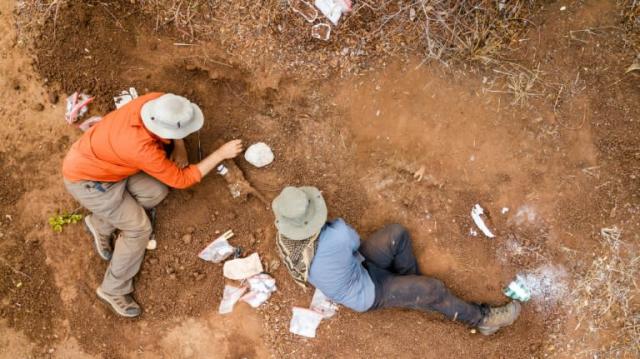This 230-Million-Year-Old African Dinosaur is the Oldest Dinosaur Species Ever

The oldest definitive dinosaur species ever discovered in Africa — and one of the oldest dino species to walk Earth — has been unearthed in Zimbabwe, a new study finds. The finding sheds new light on dinosaur evolution, and on one of the most fundamental questions of Triassic palaeontology: Why did dinosaurs live in only some parts of the ancient supercontinent Pangaea?
Scientists began working on the Pebbly Arkose Formation in northern Zimbabwe in 2017. After five years of careful excavation and COVID delays, they’ve finally unveiled the dig’s star specimen: Mbiresaurus raathi, a nearly complete skeleton named after “Mbire,” the Shona dynasty that once ruled the region.
The species’ name honours Michael Raath, who helped discover the first fossils in the area. At roughly 230 million years old, the specimen is on par with the oldest dinosaurs ever found. Their results were published online Wednesday (Aug. 31) in the journal Nature(opens in new tab).
“The earliest dinosaurs were small — far from the giants we usually think of,” Christian Kammerer, a research curator of palaeontology at the North Carolina Museum of Natural Sciences who was not involved in the research, told Live Science in an email.
The newly named dinosaur is a sauropodomorph, a relative of the towering (and iconic) long-necked sauropods like Brachiosaurus and Apatosaurus. At around 6 feet (2 meters) long, or about as long as a Shetland pony, and 1.5 feet (0.5 m) tall at the hip, M. raathi wasn’t tiny, but it would have been dwarfed by later sauropods, such as the massive 122-foot-long (37 m) Patagotitan.
M. raathi lived during the late Triassic period (252 million to 201 million years ago) along the banks of an ancient river in what would become Zimbabwe. It was a rich ecosystem, filled with more than just dinosaurs. “I think a lot of the story is about all the different animals that we found together,” study first author Christopher Griffin, a vertebrate paleontologist at Yale University, told Live Science.
The excavation unearthed numerous protomammals known as cynodonts, as well as armored crocodilians, bizarre beaked reptiles called rhynchosaurs, and even evidence of an early meat-eating dinosaur.
This assemblage almost exactly mirrors the fossils palaeontologists might expect to find an ocean away, buried in the steppes of Patagonia or tucked away in the rocky outcroppings of Brazil.
During the Triassic period, all of Earth’s continents were smooshed together into one giant landmass known as Pangaea. Because of this ancient proximity, many regions that are now separated by entire oceans — such as the coasts of South America and Africa — once shared flora and fauna. “If you draw a line across Pangaea connecting northern Argentina and southern Brazil, you cross northern Zimbabwe as well,” Griffin said.

Consequently, M. raathi closely resembles other late Triassic sauropodomorphs, like the deceptively named Eoraptor and the dog-size Saturnalia, both found in Brazil, as well as some found in India.
It remains a bit of a mystery as to why certain animal species were relegated to certain regions of Pangaea during this time. “You might think that it would be easy to traverse a supercontinent,” Steve Brusatte, a paleontologist at the University of Edinburgh in Scotland, who was not involved in the study, told Live Science, “But it seems not.”
Sites such as the Pebbly Arkose Formation, however, offer clues to this millennia-old mystery. Building on earlier research, the researchers proposed that varied climate patterns held Triassic animals in place, rather than physical boundaries like oceans.
The closely-related dinosaurs found in South America, south-central Africa and India indicate that similar animals roamed freely across this particular latitude band, but not outside of it, likely because of climatic barriers like extreme heat or drought, the researchers wrote in the study.

Dinosaurs probably didn’t disperse to the other parts of Pangaea until these climatic barriers relaxed. But the stomping grounds of other major animal groups with roots in the Triassic, including mammals, turtles, amphibians and reptiles, are still influenced today by how these climatic bands’ affected the groups’ ancestors, the team suggested.
Meanwhile, there is one other dinosaur fossil discovered in Africa that may be even older than M. raathi — Nyasasaurus, which was found in a roughly 245 million-year-old fossil formation in Tanzania.
However, Nyasasaurus is known only from a handful of bones. Taken together, they do not form a complete enough skeleton to determine whether it was a true dinosaur, or simply a dinosaur ancestor, known as a dinosauromorph. Either way, M. raathi represents a key piece in the mosaic of dinosaur lineage.
“As a rule, the discovery of a new species is very important to science,” said study co-author Darlington Munyikwa, a palaeontologist and deputy executive director of National Museums and Monuments of Zimbabwe. And, he told Live Science, the fact that this species is the oldest confirmed dinosaur in Africa makes it particularly “awesome.” The specimen now resides in the Natural History Museum of Zimbabwe in Bulawayo, where it will inspire generations of palaeontologists to come.
“We’ve known next to nothing about the earliest dinosaurs in Africa, and the discovery of Mbiresaurus changes that,” said Brusatte. “I think it is one of the most important recent dinosaur discoveries anywhere on the planet.”





